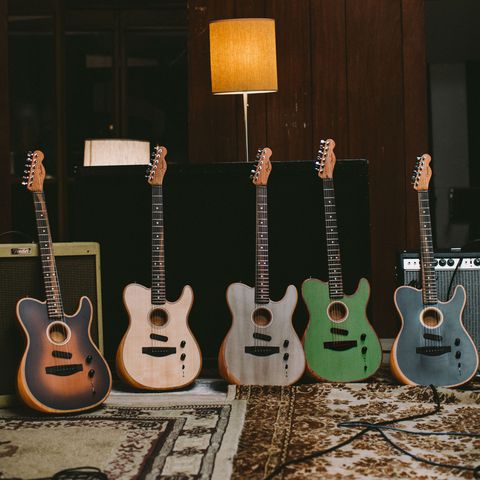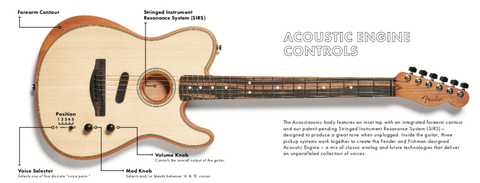Fender's 'Acoustasonic' Is a True Acoustic-Electric Hybrid Guitar
Half electric, half acoustic, fully badass.
By Henry Robertson
FENDER
It’s rare today to find a guitar with totally unique functionality and design, especially one that isn’t a cheesy novelty. Fender is really offering something special with their new Acoustasonic, a hybrid electric/acoustic guitar several years in the making. This guitar is truly an acoustic and an electric, not just an acoustic with a preamp and pickup, nor just an electric with a Piezo pickup for an added "acoustic” tone. It’s a concept all its own and one we're excited about.
The new Acoustasonic sports the classic Telecaster body, has a magnetic electric pickup, a Piezo, and a body-sensing pickup (more on that later), a soundhole, a wooden bridge, two knobs, and a bolt-on neck. There’s a DSP chip inside for a diversity of tones, but the guitar sounds anything but digital. With acoustic, electric, digital, and analog technology, it’s a hard instrument to nail down, but that's what makes it so interesting.
Acoustic-electric guitars have been around since the late '60s. With onboard preamps and pickups, these let artists play large venues with acoustic guitars without putting a mic directly on the instrument, which is a logistical hassle that can result in volume inconsistency and feedback issues. But an acoustic-electric guitar is still just an acoustic guitar that can be amplified. It won’t give you electric tones. Add distortion to your signal and you’ll get piercing feedback and out-of-control sustain, thanks to the hollow acoustic construction.
In the '90s, some electric guitar manufacturers came at the problem from the other side and added Piezos to their electrics to try and offer an approximation of an acoustic sound. While great in theory, solid-body electrics have very different constructions than acoustic guitars and the result means thin and artificial sound compared to the genuine, acoustic item.
Fender started exploring a solution to this problem with its first Acoustasonic, released in 2010, in the shape of a Telecaster. It was a good guitar but still came in heavily on the electric side of the scale. The new Acoustasonic, meanwhile, has a new design with superior build quality that improves the acoustic side appreciably without taking away from the electric side.
Building a Balance
The first formidable difference is a specially designed soundhole that Fender refers to as its Stringed Instrument Resonance System (SIRS), which gives the Acoustasonic the resonance of a fatter acoustic guitar with the thinner body of a Telecaster. When you strum the Acoustasonic unplugged, you’ll hear the genuine acoustic guitar tone. You’ll feel the air and sound vibrations coming out of the soundhole. In that way, it's truly acoustic. The 2010 version had a chambered body meaning the body is routed hollow inside, but there aren’t soundholes. This provided a unique resonance and helped suppress feedback but didn’t quite capture the essence of an acoustic guitar. The thin body size and solid sides help suppress feeback this time around, regardless if you’re using it as an acoustic or an electric.
On the electric end, the noiseless, modified Strat pickup doesn’t succumb to pesky 60 Cycle Hum like your typical single coil pickup, while it still produces the twang and chime inherent to single coils. I tested out the guitar at Fender’s media unveiling and was astonished to find I could play Slayer riffs with the gain cranked all the way up on an “acoustic” guitar.
The Acoustasonic is built from tonewoods found on acoustics rather than the woods Fender uses for its electrics. They subbed out the typical ash or alder body and maple neck for a thin spruce top and a mahogany back and neck. Spruce is a stiff, light-weight, bright sounding wood with complex harmonic overtones and robust sound projection. Mahogany, which is fairly dark and warm sounding helps round out the overall tones. The ebony fingerboard has more brightness and snap than the rosewood used on most Fender electrics. Instead of having a set-neck construction that is typical of acoustic guitars, Fender used a bolt-on neck, which produces the snappy, twangy tones characteristic of Fender electrics. Fender’s CEO, Andy Mooney, brought up a good point on why they opted for this kind of neck and I feel it speaks to the general philosophy behind their guitars. He told me, “When Leo Fender started this company, he wanted his guitars to be serviceable and customizable. With a bolt-on guitar, you can swap out the neck if you want. If something breaks, you can fix it. You can make adjustments more easily.”
When I first saw the Acoustasonics, I was struck by the ornate, gorgeous finishes on the guitars. Recently exploring how paint finishes affect tone, I asked about what the finishes were made of. It turns out they are screen printed finishes. While Fender is keeping info on the technology behind the finishes under wraps for the time being, the possibilities are alluring and the technology is a testament to Fender’s ethos of customization. Mooney explained “because the finishes are screen printed, it opens the doors for customization and one-off guitars. If you’re obsessed with your dog, hypothetically you can take a picture of your dog and make that your finish.” Wild stuff.

FENDER MUSICAL INSTRUMENTS CORPORATION
For electronics, the guitar has a five-way selector switch like on a Stratocaster, but it’s more than a pickup selector switch. You’ll see two knobs—one is a simple volume control, the other is NOT the expected tone control. Referred to as the “mod control,” it’s interactive with the selector switch and allows you to switch between and blend dual voices, "A" and "B" that are unique to each position. In position 1 you’re only engaging the electric pickup. In position 2 you can blend the electric signal into your fundamental acoustic guitar tone. Position 3 adds in the body sensing pickup to your acoustic tone. It’s a pickup tucked underneath the body that amplifies the “Z” axis of the top, meaning the top movement up and down towards the soundhole. This allows for amplified percussive tapping on the acoustic’s body, like you’d hear in Flamenco guitar. In position 4 and 5 you can switch between different acoustic body types (e.g., Dreadnought, Parlor, Auditorium, etc.), which emphasize different frequencies and are suited to different genres and playing techniques like full bodied strumming or delicate finger picking.
For unprecedented flexibility, user friendliness, and high-end sound quality, the Acoustasonic makes sense for a wide swath of serious musicians. The ability to record direct with the guitar rather than having to mic the instrument or the amp that the signal is coming through means extraneous noises won’t bleed into your recordings, a huge benefit whether you record at home or with a professional studio engineer. The battery which powers the DSP is rechargeable via USB and lasts about 20 hours between charges for added convenience.
The new Acoustasonic isn’t cheap, going for $2,000. But considering the build quality, the vast array of tonal options on tap, and user friendly controls, it’s a very fair price. Mooney told me a central tenet of Fender is to “provide the best product for working musicians that Leo would design with form following function.” The Acoustasonic delivers this in spades. For a high-grade acoustic and electric in one enclosure, it's an exciting development and one that changes the perception about what a guitar can do and be, which will hopefully inspire musicians in unforeseen ways. Now let’s see if Fender comes out with a Stratocaster Acoustasonic…
No comments:
Post a Comment